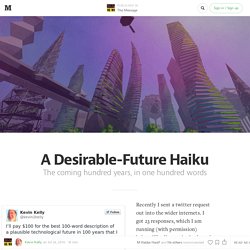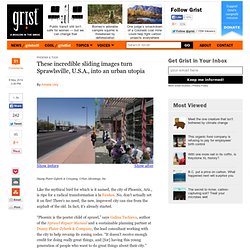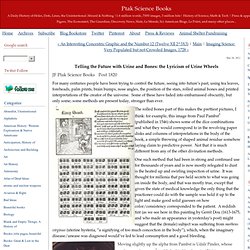

12-Risks-with-infinite-impact-full-report-1. Onlinelibrary.wiley.com/store/10.1111/1467-6486.00225/asset/1467-6486.00225.pdf?v=1&t=i350q8gv&s=2ca1d1d130a5be5a38555e4c8e9c344cfbd83c58. A Desirable-Future Haiku — The Message. Recently I sent a twitter request out into the wider internets.

I got 23 responses, which I am running (with permission) below. I’ll tell you who I selected as the winner in a moment, but first I’d like to tell you what I learned. It’s a hard assignment. Compressing anything as messy as the future into 100 words is a near-impossible challenge. Almost like writing poetry. This exercise began with my dissatisfaction with the visions of our future today available in movies and science fiction. I am not asking for utopia. It might be that such a pragmatic protopia is so boring and square that it can’t inspire us beforehand. It also may be that there is a vacuum of desirable futures next century because none are possible. These incredible sliding images turn Sprawlsville, U.S.A., into an urban utopia. Duany Plater-Zyberk & Company.

Urban Advantage, Inc. Like the mythical bird for which is it named, the city of Phoenix, Ariz., is ripe for a radical transformation à la Fawkes. No, don’t actually set it on fire! 211, William Gibson. Get more interviews like this—plus fiction, poetry, art, and more—and subscribe to The Paris Review today!

Vancouver, British Columbia, sits just on the far side of the American border, a green-glass model city set in the dish of the North Shore Mountains, which enclose the city and support, most days, a thick canopy of fog. There are periods in the year when it’ll rain for forty days, William Gibson tells me one mucky day there this winter, and when visibility drops so low you can’t see what’s coming at you from the nearest street corner. But large parts of Vancouver are traversed by trolley cars, and on clear nights you can gaze up at the wide expanse of Pacific sky through the haphazard grid of their electric wires. Gibson came to Vancouver in 1972, a twenty-four-year-old orphan who’d spent the past half-decade trawling the counterculture in Toronto on his wandering way from small-town southern Virginia.
Pattern Recognition was the first of that series. —David Wallace-Wells. Exploring the Future of the Digital Divide through Ethnographic Futures Research. Exploring the Future of the Digital Divide through Ethnographic Futures Research by Matthew M.

MitchellThis study examines leaders who work for social change in an information society. Grounded in the notion that leadership and social change are necessarily future oriented, this study attempts to learn how those who lead the effort to ameliorate the digital divide in Washington State perceive the optimistic, pessimistic, and most probable futures. In this study, the digital divide is framed as a social problem that is caused, in part, by inequities in the ability to access and to use information communication technologies.
Furthermore, this study is concerned that the digital divide impacts the opportunities for participation in social and economic arrangements, which may be a threat to social and economic justice. Aisel.aisnet.org/cgi/viewcontent.cgi?article=1047&context=icis2009. The ethnographic futures research method: An application to Thailand. Scenario Planning Tool Development. Scenario Planning Tool Development The Lincoln Institute Policy Focus Report Opening Access to Scenario Planning Tools summarizes the challenges, opportunities, and recommendations of these workshops and provides information on scenario planning activities, tools and needs was released April 13, 2012 at the national conference of the American Planning Association. Download the report from the Lincoln Institute of Land Policy website.
A number of tool developers, users, and funders are collaborating with Western Lands and Communities to support the enhancement of visioning and scenario planning tools in an open source environment – with the objective of greatly increasing the compatibility, access, affordability and usability of these tools for a much broader audience. We focus on straightforward and easy to use scenario tools, not on the more complex urban or econometric models. Publications Scenario Planning Tools for Sustainable Communities , Jim Holway for October, 2011 Land Lines. Opening Access to Scenario Planning Tools. Telling the Future with Urine and Bones: the Lyricism of Urine Wheels. JF Ptak Science Books Post 1820 For many centuries people have been trying to control the future, seeing into future’s past, using tea leaves, foreheads, palm prints, brain bumps, nose angles, the position of the stars, rolled animal bones and printed interpretations of the creator of the universe.

Some of these have faded into embarrassed obscurity, but only some; some methods are present today, stronger than ever. The rolled bones part of this makes the prettiest pictures, I think: for example, this image from Paul Pambst1 (published in 1546) shows some of the dice combinations and what they would correspond to in the revolving paper disks and columns of interpretations in the body of the book, a simple throwing of shaped animal residue somehow laying claim to predictive power.
Not that it is much different from any of the other divination methods. “Slightly red as a lowered flame of fire” and “Red as a flame of fire not lowered” They’re lovely! Notes: 1. 2. 3. Albus color ut aqua fontis.